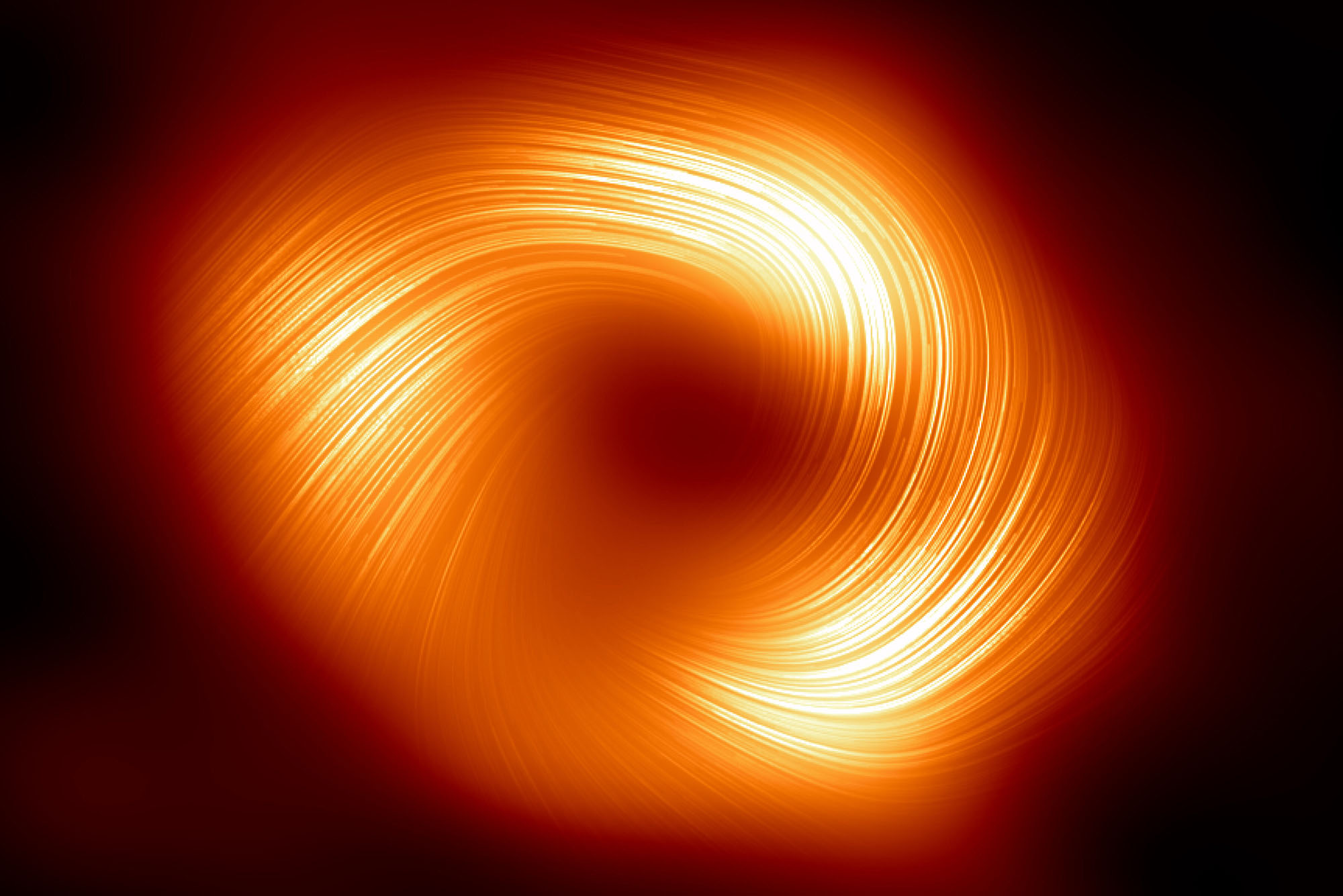Stunning New Image Shows Black Hole’s Immensely Powerful Magnetic Field
BU researchers, part of international black hole collaboration, explain image of supermassive cosmic object at the center of the Milky Way

A new view of the Milky Way’s supermassive black hole Sagittarius A* in polarized light shows its magnetic field. Image EHT Collaboration
Stunning New Image Shows Black Hole’s Immensely Powerful Magnetic Field
BU researchers, part of international black hole collaboration, explain image of supermassive cosmic object at the center of the Milky Way
The clear, swirling lines give some hint at the supermassive black hole’s power: a spiraling magnetic field helping haul in just about anything that sits nearby. It’s the first time scientists have captured an image of the magnetic fields coiling around Sagittarius A*, or Sgr A*, a giant black hole at the center of the Milky Way with a mass four million times that of the sun.
The image was unveiled by the Event Horizon Telescope (EHT) Collaboration, an international team of more than 300 experts—including two Boston University scientists. Alan Marscher, a BU College of Arts & Sciences professor of astronomy, and Svetlana Jorstad, a BU Institute for Astrophysical Research senior research scientist, also contributed to our first glimpse of Sgr A*, revealed in 2022, and the first ever black hole image, at the center of the Messier 87, or M87, galaxy, in 2019.
The EHT team says the new image shows a magnetic field structure similar to one they’ve observed around M87, a much larger, but more distant black hole. Magnetic fields are what allow black holes to draw in and gobble up matter and throw out huge jets full of particles. The researchers published the image and their analysis in the Astrophysical Journal Letters.
“A static image in polarized light shows the twisted, but organized magnetic field near the black hole at the center of the Milky Way galaxy, which is very similar to that of the black hole at the center of the M87 galaxy, suggesting that strong twisted magnetic fields may surround all black holes,” Jorstad and Marscher said in a joint statement to The Brink.
And it’s all happening in our (relatively, cosmically speaking) neighborhood. Sgr A* is a mere 27,000 light-years from Earth; M87 is about 55 million light-years away. One light-year is the equivalent to just under six trillion miles.
“The fact that the magnetic field structure of M87 is so similar to that of Sgr A* is significant because it suggests that the physical processes that govern how a black hole feeds and launches a jet might be universal among supermassive black holes, despite differences in mass, size, and surrounding environment,” says Mariafelicia De Laurentis, EHT’s deputy project scientist and a professor at the University of Naples Federico II in Italy. “This result allows us to refine our theoretical models and simulations, improving our understanding of how matter is influenced near the event horizon of a black hole.”
The Event Horizon Telescope is actually a network of individual radio telescopes, or dishes, around the world, stretching from Europe and the Americas to the South Pole. Linking them creates what the collaborative calls an “Earth-sized interferometer,” or tool for studying light interference.
Although the first black hole image in 2019 astounded many and excited scientists, it also became a social media meme with some underwhelmed by the fuzzy, indistinct ring—comparing it unfavorably to unfocused photos of a bagel or doughnut.


The first visual evidence of the black hole in the center of Messier 87 (left) and the first of Sagittarius A* (right). Images courtesy of EHT
Despite the new image appearing to be significantly higher in resolution, Jorstad and Marscher say it’s actually because it shows the black hole in polarized light. With polarization, the light’s electromagnetic waves happen in one plane rather than vibrating all over the place—just like when you slip on a pair of polarized sunglasses to sharpen your vision and cut the glare on a sunny day. “Polarization adds information that can make the image appear to have higher resolution, since it separates regions with different magnetic field directions,” according to Jorstad and Marscher.
With plans to add more radio dishes to its network, including as far north as Greenland, the team hopes to soon be able to share even more impressive black hole images—and perhaps movies.
“Each year, the EHT Collaboration adds more telescopes, larger bandwidth, and new observing frequencies, and develops new imaging techniques, which will allow us to improve the images,” Jorstad and Marscher told The Brink. “These expansions will enable the creation of high-fidelity movies of M87 and Sgr A*; to reveal a hidden jet in Sgr A*, if present; to see a connection between the photon ring and jet in M87; and observe unpolarized and polarized light structures in the vicinity of other black holes.”

Comments & Discussion
Boston University moderates comments to facilitate an informed, substantive, civil conversation. Abusive, profane, self-promotional, misleading, incoherent or off-topic comments will be rejected. Moderators are staffed during regular business hours (EST) and can only accept comments written in English. Statistics or facts must include a citation or a link to the citation.